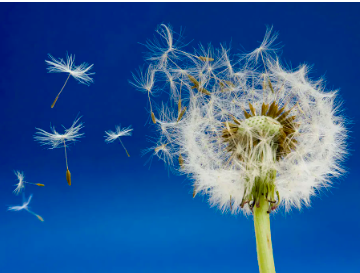Plant Propagation
Many plants spread (propagate) themselves through their seeds and root extensions. But sometimes, man wants to propagate more plants, especially plants that are genetically the same as the parent plant. Plant propagation is the process of creating new plants. There are two types of propagation: sexual and asexual. Sexual reproduction is the union of the pollen and egg, drawing from the genes of two parents to create a new, third individual. This individual is genetically different from its parent plant. Sexual propagation involves the floral parts of a plant. As a quick review: seed formation requires cells from the stamen (male) to attach to the pistol (female) parts of the flower. The fertilized cell in the ovum of the pistol will form a plant embryo, surrounded by food and encased in an outer coat-all of this forming a seed.

Different seeds are adapted to different dispersal methods such as wind, water, and animals. Burrs hitch rides on people and pets while wind disperses smaller seeds and those with “sails” such as MIlkweed. And of course, consider the lowly dandelion!


This is a serious consideration in planting as seeds can spread long distances. Species that are not native to an area can quickly become a problem crowding out native species that provide food and shelter to native animals decreasing the available food and shelter ultimately decreasing the animals that depend upon the natives. Consider the limited number of buterflies, bees and even birds in the urban area. Bush honeysuckle is a non native species that has grown rampant in our area but it does not provide food or shelter to our native animals. Walking along the Hodiamont Tracks and vacant lots in the area, bush homeysuckle has literally taken over in many places. By removing the bush honeysuckle and replacing it with native plants, the natural pollinators of birds, bees and butterflies will return. Consider what had to be done along the Mural Wall as an example.

Asexual propagation involves taking a part of one parent plant and causing it to regenerate itself into a new plant. The resulting new plant is genetically identical its parent. Asexual propagation involves the vegetative parts of a plant: stems, roots, or leaves. For some plants, cuttings from the stem, root or leaf will propagate new plants while for other plants, layering, separation, grafting or budding is necessary. While most of these methods creates a genetically identical plant, grafting and budding create a genetically identical plant ABOVE the graft but still retaind the genetic identity of the root stock BELOW the graft. There are many ways, too numerous for this lesson, to do cuttings, layering, division and grafting, an understanding of the process with classic examples follows.
Cuttings
Many types of plants, both woody and herbaceous, are frequently propagated by cuttings. A cutting is a vegetative plant part which is severed from the parent plant in order to regenerate itself, thereby forming a whole new plant genetically identical to the parent plant. African violets will propagate by placing a petiole and leaf in new soil producing many new geneticlly identical plants. Geraniums and impatiens will also propagate through cuttings. Any time you place a cutting of a plant in water to create new roots (such as philodendron) you are using cuttings to propagate the plant.

Layering
Stems still attached to their parent plants may form roots where they touch a rooting medium. Severed from the parent plant, the rooted stem becomes a new plant. This method of vegetative propagation, called layering, promotes a high success rate because it prevents the water stress and carbohydrate shortage that plague cuttings. Classic example is the philodendron house plant. Lay a long stem on additional soil in another pot and soon there will be a new plant in the new pot. The stem connecting them then can be cut.

Division
Plants with more than one rooted crown may be divided and the crowns planted separately. If the stems are not joined, gently pull the plants apart. If the crowns are united by horizontal stems, cut the stems and roots with a sharp knife to minimize injury. Divisions of some outdoor plants should be dusted with a fungicide before they are replanted. Examples: daffodils, dahlias, iris, rhubarb, day lilies. In fact for iris, lilies and daffodils, they need to be divided every few years to continue blooming. African violets can also be divided this way.

Grafting
Grafting and budding are methods of asexual plant propagation that join plant parts so they will grow as one plant. These techniques are used to propagate cultivars that will not root well as cuttings or whose own root systems are inadequate. While we will not be doing this, it is a very common practice. Fruit trees such as all the hybrid apples, peaches and pears are grown on grafted root stock. The root stock is usually a native apple, peach or pear that is very hardy but does not produce particularly popular fruit. While we are not planting fruit trees, trees that have been grafted need special care. The graft area (usually looks like a thick area of the trunk a few inches above the main roots) must be planted above ground. Any branches growing from below the graft must be cut off as those branches are from the root stock and drain energy from the grafted plant. This is also a very common method to propagate roses.

Propagation is a specialty unto itself. It often requires sterile techniques, special plant mediums such as perlite or Candian moss, specific tools and a lot of patience. If interested in going further into plant propagation, there are many excellent references on the subject.



